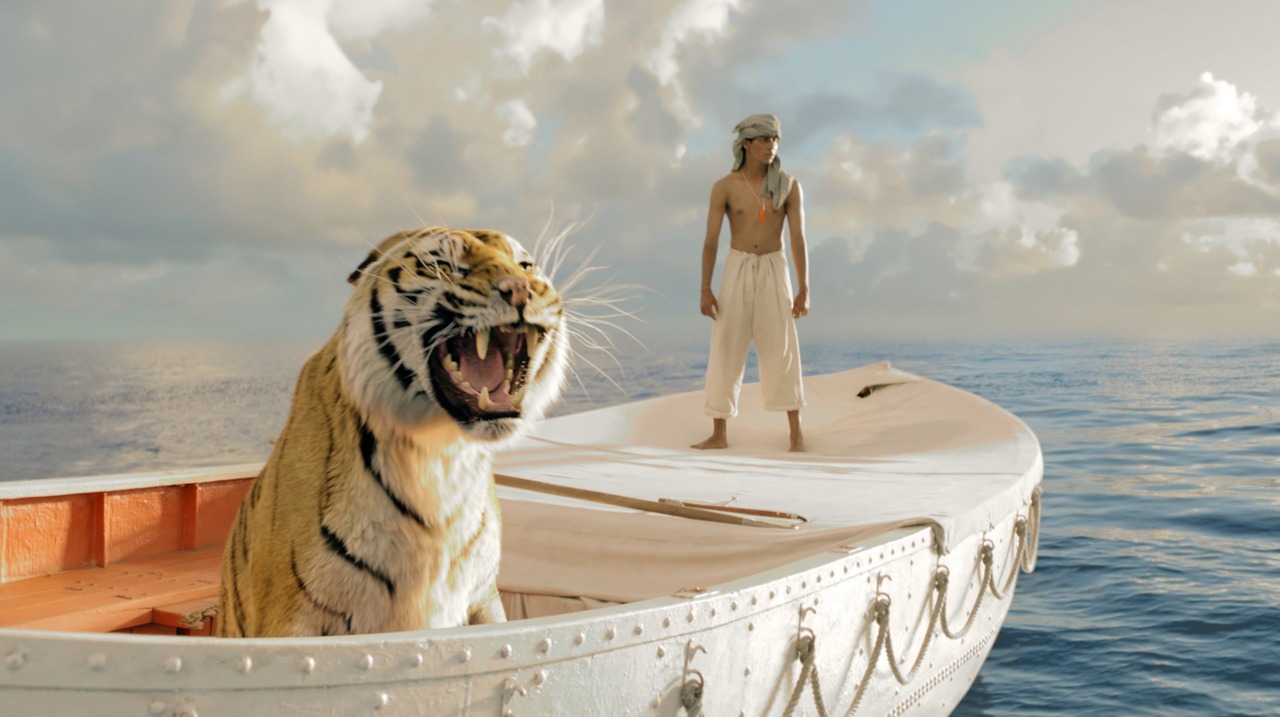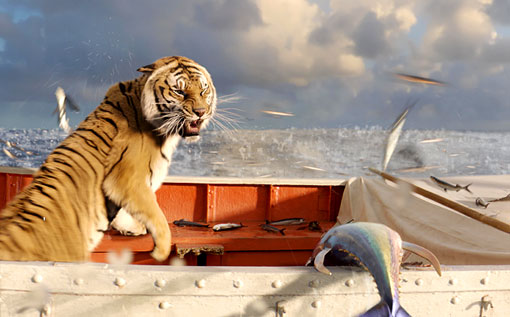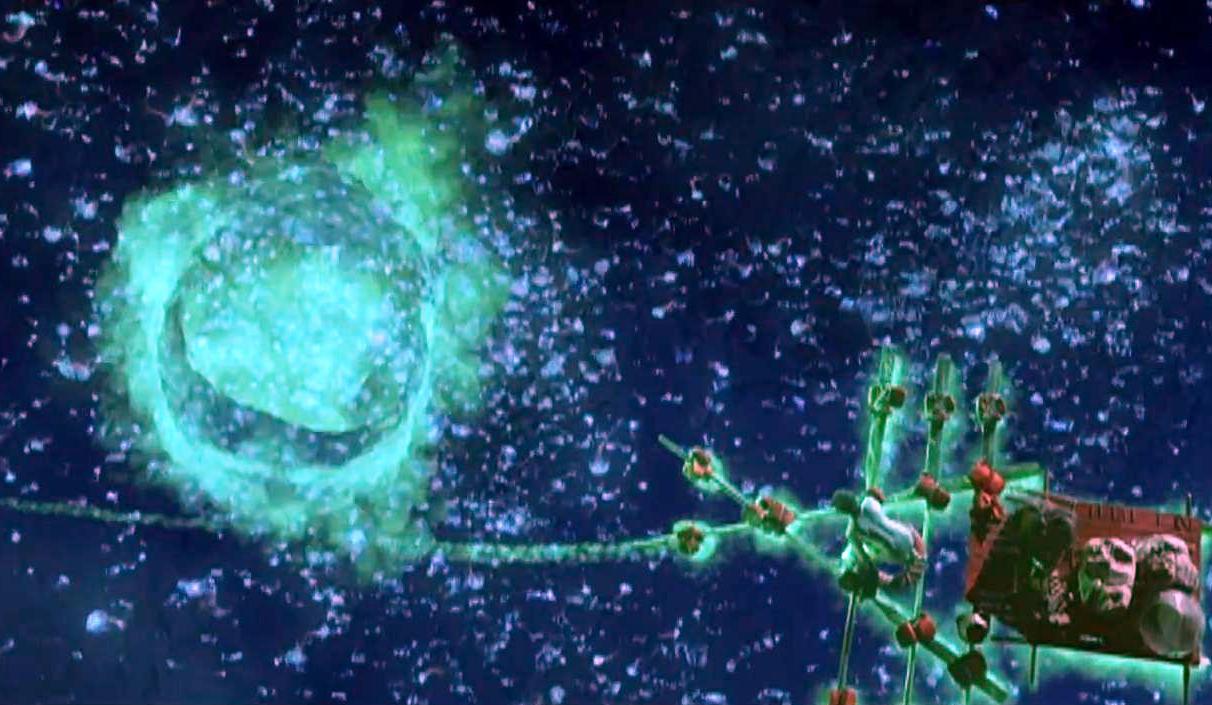|
Based
on the 2001 novel by Yann Martel, Life of
Pi is the metaphysical and spiritual journey of a character who
must
question their physical endurance and willingness to sustain their
faith in
God. This character is named Pi Patel and we first see him in present
day
Canada as a man (played by Irrfan Khan) who is preparing to tell an
amazing
story to a writer (Rafe Spall). Pi's story begins at a young age when
he is a
schoolboy in India. His parents are strict but intelligent and run a
zoo with a
huge array of animals. The film traces Pi's life to when he is a young
man (Suraj
Sharma), who is reluctant to join his parents once they sell the zoo
and move
overseas. Once onboard a Japanese ship transporting the zoo animals to
be sold,
a huge storm floods the vessel and Pi is separated from his family. He
finds himself
in a lifeboat with a zebra and somehow survives the storm. A fantasy
adventure
of imagination begins, where several other animals emerge from under
the covers
of the lifeboat, including a tiger. Fearful of the tiger, Pi resorts to
building himself a mini raft attached to the boat. He must use a
survival guide
and other skills to control the tiger and retake the lifeboat.
Director
Ang Lee has never made the same film twice. His constant versatility
and
creative mind for unique visual spaces defines his work. His films
including Hulk, Crouching Tiger, Hidden
Dragon and Brokeback Mountain each adopted a
unique filmic style appropriate
to the material. Only someone with such diverse and sophisticated
formal
knowledge like Lee could have made Life
of Pi work as well as it does. Once deemed unfilmable, the film's
visual
sophistication bridges the gap between an art house project and
mainstream
blockbuster. Its stunning visual qualities do not stand isolated but
provide
cinematic representations of complex philosophical questions
surrounding myths,
religion and faith.

In
lesser hands this might have been a more bloated, less intelligent
film. Before
Lee, the project was passed between several directors including
Jean-Pierre
Jeunet, Alfonso Cuaron and M. Night Shyamalan, all of whom are
considered
visual stylists. Lee's personal strength as a filmmaker is that he
rarely
allows images to be devoid of meaning. His approach to this complex
material is
wholly cinematic: he challenges the
audience to draw meaning from the properties of the screen and the
images,
realising a film that is in equal parts dazzling, thoughtful and
ambiguous.
The
only stumbling points are the early scenes where Lee deters from his
cinematic approach.
The jumble of anecdotes, including Pi being named after a swimming
pool, are
confused and estranged from the rest of the film. But the screenplay by
David
Magee finds its footing once it adopts a linear structure to tell Pi's
life
story. Expositional dialogue is skilfully masked as provocative
philosophical statements,
which are then attached to the film's Biblical imagery. The film's
midsection,
spent almost exclusively on the raft with the animals, visualises Pi's
desolated world and draws parallels to stories like Noah's Ark.

The
animals in these scenes are a powerful example of Lee's emphasis on
combing theme and image. Early in the film Pi
shows great interest in the tiger. But his father says to him: "When
you look into its eyes, you see only your own
emotions reflected back at
you". This statement is problematised by the displacement of the
animals
on the raft. Are the animals real or part of Pi's imagination? The
animals, I
think, reflect Pi's shifting emotional states. When Pi is afraid, the
tiger
shows more aggression. When he learns to tame the animal, it shows more
control. These images are also allegories for God's own existence. If
one fears
God, like Pi fears the dominance of the tiger, doesn't that project our
own
vision of God in our minds? The basis
of the film is therefore how much faith we are willing to place into
something
that might only be a state of mind.
Using a
number of aesthetic devices, the film makes a dazzling case for the
power of imagination
and visual stylisation over conventional naturalism. Colour
desaturation is
used purposely, with the white tones of Pi's clothes stressing his
desire for a
cleansing experience on the boat but perhaps also to show impending
death given
the unlikelihood of his survival. The tiger's half of the boat is
coloured red.
It matches the colour of tiger to instigate a place of fear that Pi
must
overcome. Lee also allows his camera to be unconstricted by reality.
The
fluidity and tilting movements of the camera are used to stunning
effect in a
storm sequence that takes on Biblical and apocalyptic proportions.
There are
gentler moments of great power too, where Lee opts to take us deep
under the
ocean, delivering some of the most striking images in cinema. Abstract
and
impressionistic images, like a sea of blue neon lights under the ocean,
are
enhanced spectacularly by bursts of colour and unintrusive 3D effects.

To define precisely
what these scenes mean, and many others including a bizarre episode
involve
thousands of fish and an island of meerkats, would be futile. The film
isn't
concerned with facts, logic or realism. It stresses how stories and
myths
inspire our survival as a species. Posing a belated question about what
type of
stories we would rather hear, inspiring fantasy or scientific rationale
like
the survival of the fittest, is clever because the answer is
predetermined by
the amazing things we've already seen. There's a small end moment where
the
film undermines its sophisticated ambiguity by explaining a twist too
neatly
but minor quibbles never deter from the power of Lee's craftsmanship.
Life of
Pi has the spectacle of a blockbuster but compliments its flair with
heart and
intelligence - compelling reasons see this astonishing film on the big
screen.
|